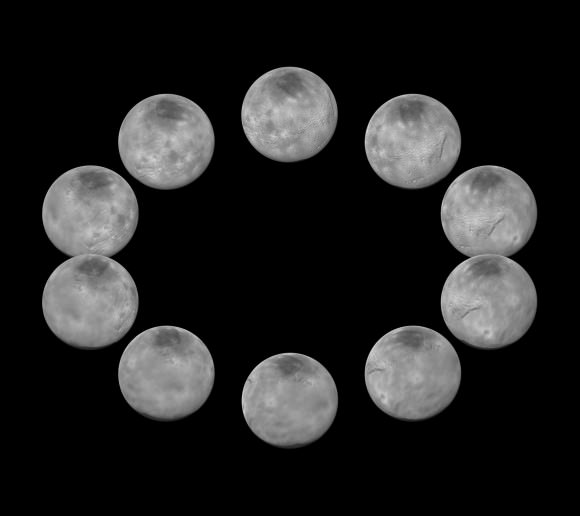A day on Pluto is 6.4 Earth days (6 days 9 hours and 36 minutes) long. That’s a lengthy, cold, and rather dark day. But this new image released by the New Horizons spacecraft team gives us a better idea of what a day on Pluto might be like. This montage of images shows Pluto rotating over the course of a full Pluto day.
It is interesting to note that Pluto’s moon Charon is tidally locked around Pluto, so this means that Charon takes 6.4 Earth days to orbit around Pluto – the same amount of time as a day on Pluto. If you were standing on Pluto, Charon would always be at the same place in the sky, or you wouldn’t be able to see it at all. And vise versa if you were on Charon.
New Horizons also captured a full day rotation for Charon, too, which you can see below.

The images were taken by the Long Range Reconnaissance Imager (LORRI) and the Ralph/Multispectral Visible Imaging Camera as New Horizons zoomed toward the Pluto system, and in the various images the distance between New Horizons and Pluto decreased from 5 million miles (8 million kilometers) on July 7 to 400,000 miles (about 645,000 kilometers) on July 13, 2015.
The science team explained that in the Pluto montage, the more distant images are at the 12 to 3 o’clock position, and so these are the best views we have of the peculiar “bumps” or impact craters on the far side. The side New Horizons saw in most detail – what the mission team calls the “encounter hemisphere” – is at the 6 o’clock position. The most prevalent feature there is the heart-shaped, “Tombaugh Regio” area that made us all love Pluto even more.
The odd shape of Pluto in the 12 and 1 o’clock position images aren’t lumps and deformities, but just artifacts from the way the images were combined to create these composites.
For the Charon montage, the images at the 9 o’clock position were taken from the greatest distance, with few of the signature surface features visible, such as the cratered uplands, canyons, or rolling plains of the region informally named Vulcan Planum. The side New Horizons saw in most detail, during closest approach on July 14, 2015, is at the 12 o’clock position.
As a comparison, below is a timelapse view of the Pluto-Charon orbital dance, which was taken by New Horizons back in January 2015. Pluto and Charon were observed for an entire rotation of each body, the same 6 days 9 hours and 36 minutes.

Source: New Horizons


Maano mAn, is this the longest flyby ever or what? Don’t get me wrong.. I like!
Are these the highest resolution images we can expect to see?
Hmmm. 12:18AM? Aqua, your brain must have been waterlogged. I figured they were selected from a lot of shots and then scaled to one size to show rotation around the common gravimetric center. (If that’s a correct term.) The scale would thus be dictated by the picture with the poorest resolution. There have been lots of other pics with *much* better resolution as I’m sure you know.
Looking at these images, if Charon were off (out of sight) to the right, say, it would be looking at the leftmost image of Pluto in this circle of images. Are you awake enough now to follow this?
Great illustration of orbit around a barycentre
Steve, thanks for the correct term. I sort of wish someone would do an mpeg or gif of an external barycenter system like that of Pluto/Charon, as close to scale as might still be useful. I know you and Aqua and I understand it but I also know that many don’t. They may never have been on the long end of a teeter-totter with a really big person on the other end.